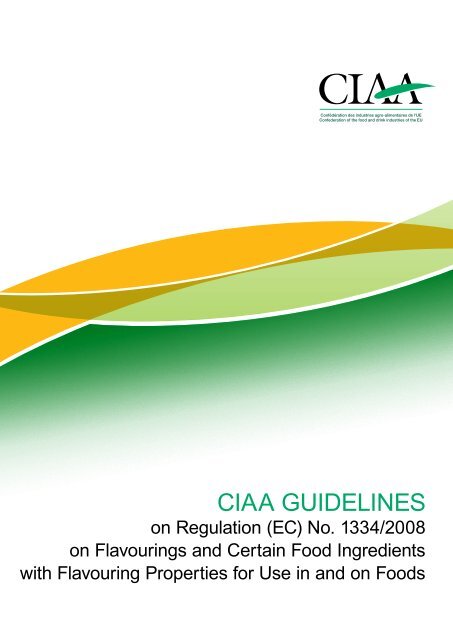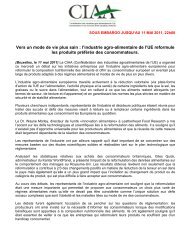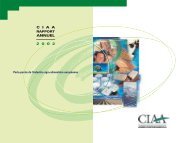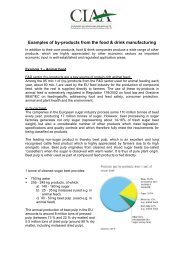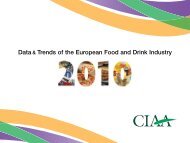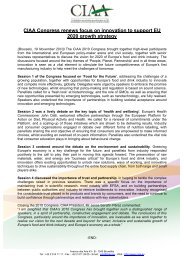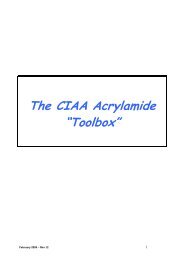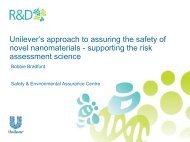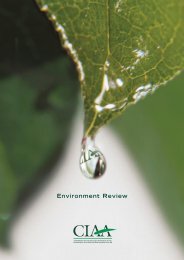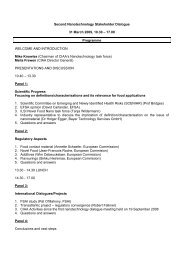CIAA GUIDELINES - FoodDrinkEurope
CIAA GUIDELINES - FoodDrinkEurope
CIAA GUIDELINES - FoodDrinkEurope
You also want an ePaper? Increase the reach of your titles
YUMPU automatically turns print PDFs into web optimized ePapers that Google loves.
<strong>CIAA</strong> <strong>GUIDELINES</strong><br />
on Regulation (EC) No. 1334/2008<br />
on Flavourings and Certain Food Ingredients<br />
with Flavouring Properties for Use in and on Foods
Table of contents<br />
EXECUTIVE SUMMARY . . . . . . . . . . . . . . . . . . . . . . . . . . . . . . . . . . . . . . . . . . . . . . . . . . . . . 3<br />
1 . SCOPE AND DEFINITIONS . . . . . . . . . . . . . . . . . . . . . . . . . . . . . . . . . . . . . . . . . . . . . . . 4<br />
1.1 Scope: Article 2 ...................................................... 4<br />
1.2 Definitions: Article 3 ................................................... 4<br />
a) Flavourings ........................................................ 4<br />
b) Food ingredients with flavouring properties. ............................... 6<br />
c) Source materials .................................................... 6<br />
2 . TIMESCALE . . . . . . . . . . . . . . . . . . . . . . . . . . . . . . . . . . . . . . . . . . . . . . . . . . . . . . . . . . . 7<br />
3 . SALES DESCRIPTION FOR FLAVOURINGS . . . . . . . . . . . . . . . . . . . . . . . . . . . . . . . . . 8<br />
USE OF ThE TERM<br />
3.1 'natural': Art. 16 (2) .................................................... 8<br />
3.2 'natural X flavouring': Art. 16 (4). .......................................... 8<br />
a) The 95/5 rule ...................................................... 9<br />
b) What can 'X' be: 'food or food category or source material'? ................. 9<br />
3.3 'natural X flavouring with other natural flavourings': Art. 16 (5) ................... 10<br />
3.4 'natural flavouring': Art. 16 (6) ........................................... 10<br />
3.5 'natural flavouring substance(s)': Art. 16 (3) ................................. 11<br />
4 . LABELLING OF FLAVOURINGS IN ThE INGREDIENTS LIST OF FLAVOURED<br />
FOOD AND DRINKS . . . . . . . . . . . . . . . . . . . . . . . . . . . . . . . . . . . . . . . . . . . . . . . . . . . . 12<br />
4.1 Case of a manufacturer of a finished product using several flavourings ........... 13<br />
in the same food. ......................................................<br />
4.2 Case of a manufacturer of a finished product using several flavourings ........... 14<br />
in several foods. .......................................................<br />
4.3 Case of flavourings containing a smoke flavouring which imparts a smoky note .... 15<br />
to the food: Art. 29 .....................................................<br />
4.4 Additional labelling examples ........................................... 16<br />
5 . UNDESIRABLE SUBSTANCES LISTED IN ANNEX III - ARTICLE 6 . . . . . . . . . . . . . 17<br />
5.1 Substances which may not be added as such to foods ....................... 17<br />
5.2 The 'major contributors approach' ....................................... 17<br />
5.3 Special cases: Annex III B ............................................. 18<br />
5.4 Link with Directive 88/388/EEC. ......................................... 18<br />
6 . COMMUNICATION AND MONITORING OF INTAKE DATA . . . . . . . . . . . . . . . . . . . . 19<br />
6.1 Information to be communicated by food business operators: Art. 19 ............ 20<br />
6.2 Intake and reports from Member States: Art. 20 ............................ 20<br />
7 . ORGANOLEPTIC CONTROLS . . . . . . . . . . . . . . . . . . . . . . . . . . . . . . . . . . . . . . . . . . . . 20<br />
ANNEX I - TIMESCALE FOR APPLICATION . . . . . . . . . . . . . . . . . . . . . . . . . . . . . . . . . . . 21<br />
I.1 Entry into force and date of application of the Regulation: Art. 30 ......... 21<br />
I.2 End of marketing of non-complying foods and flavourings: Art. 30 ........ 21<br />
a) Labelling compliance ......................................... 22<br />
b) Compliance with the formulation of flavourings: Annexes III to V ........ 22<br />
I.3 Community list of flavourings and source materials: Arts. 8 to 13. ......... 22<br />
I.4 Situation at Member State level ................................... 23<br />
ANNEX II - WhAT hAS ChANGED? . . . . . . . . . . . . . . . . . . . . . . . . . . . . . . . . . . . . . . . . . . 24<br />
II.1 Scope ...................................................... 24<br />
II.2 Maximum level of certain substances - Annex III Part B. ................ 24<br />
II.3 Labelling of flavourings intended for sale to the final consumer ........... 25<br />
2<br />
<strong>CIAA</strong> <strong>GUIDELINES</strong> ON REGULAtION (EC) N°1334/2008 ON FLAvOURINGS AND CERtAIN FOOD INGREDIENtS wIth FLAvOURING PROPERtIES FOR USE IN AND ON FOODS
Executive summary<br />
The <strong>CIAA</strong> Guidelines on the 'Regulation (EC) No. 1334/2008 on flavourings and certain food<br />
ingredients with flavouring properties for use in and on foods' are intended to provide a common<br />
understanding of the major issues to be taken into account by food business operators, flavourings<br />
producers and other stakeholders.<br />
The Guidelines are divided into different chapters and Annexes and include the original text as<br />
provided in the Regulation, food and drink manufacters' and flavourings producers' interpretations<br />
and common understanding of the Regulation, and some illustrative examples to highlight specific<br />
cases. The Commission's view on industry's understanding is included in these Guidelines where<br />
applicable.<br />
Chapter 1 provides a brief overview on the scope and definitions provided in the Regulation,<br />
including some illustrative examples.<br />
Chapter 2 highlights a summary diagram on the timescale for implementation, where additional<br />
information and national specific issues are provided in Annex I.<br />
Chapter 3 sets out sales descriptions for flavourings, including the use of the term 'natural' and<br />
its possible designations.<br />
Chapter 4 examines the possibilities of labelling flavourings in the ingredients list of flavoured<br />
products, and provides different examples.<br />
Chapter 5 elaborates on undesirable substances as listed in the Regulation.<br />
Chapters 6 and 7 are devoted to the communication of data and monitoring of intake and<br />
organoleptic controls.<br />
Annex II analyses the major differences between the Regulation and the former<br />
Directive 88/388/EC.<br />
NOTE: These Guidelines developed by <strong>CIAA</strong> members, were based on ANIA interpretative<br />
Guidelines on the new flavourings Regulation and EFFA Guidelines.<br />
Disclaimer:<br />
These Guidelines are intended to provide a common understanding on the major issues to be<br />
taken into account. The statements and interpretations provided in these Guidelines aim to reflect<br />
a European-wide perspective and should not prejudice national interpretations. Ultimately, it is a<br />
matter for each company to determine the appropriate interpretation.<br />
3<br />
<strong>CIAA</strong> <strong>GUIDELINES</strong> ON REGULAtION (EC) N°1334/2008 ON FLAvOURINGS AND CERtAIN FOOD INGREDIENtS wIth FLAvOURING PROPERtIES FOR USE IN AND ON FOODS
1 Scope and definitions<br />
1.1 Scope: Article 2<br />
The Regulation applies to:<br />
a) Flavourings used or intended to be used in or on foods and to source materials for flavourings;<br />
b) Food ingredients with flavouring properties and to source materials for these ingredients;<br />
c) Foods containing flavourings and/or food ingredients with flavouring properties.<br />
The Regulation does not cover:<br />
a) Substances which have an exclusively sweet, sour or salt taste, such as sugar, salt or citric<br />
acid;<br />
b) Raw foods;<br />
c) Non-compound foods and mixtures such as, but not exclusively, fresh, dried or frozen spices<br />
and/or herbs, mixtures of tea and mixtures for infusions as such, as long as they have not been<br />
used as food ingredients.<br />
1.2 Definitions: Article 3<br />
a) Flavourings<br />
Article 3 (2) (a) - ‘Flavourings’ shall mean products:<br />
(i) not intended to be consumed as such, which are added to food in order to impart or modify<br />
odour and/or taste;<br />
(ii) made or consisting of the following categories: flavouring substances, flavouring preparations,<br />
thermal process flavourings, smoke flavourings, flavour precursors or other flavourings or<br />
mixtures thereof.<br />
Each of the categories described below is a 'flavouring'. The term flavouring can apply to a product<br />
consisting of only one of these categories or a mixture of several of the categories. They can be<br />
combined with food ingredients and/or food additives incorporated for technical purposes.<br />
- Flavouring substances<br />
Article 3 (2) (b) - ‘Flavouring substance’ shall mean:<br />
a defined chemical substance with flavouring properties.<br />
Example:<br />
• Flavouring substance: menthol, ethyl butyrate.<br />
- Natural flavouring substances<br />
Article 3 (2) (c) - ‘Natural flavouring substance’ shall mean:<br />
a flavouring substance obtained by appropriate physical, enzymatic or microbiological processes<br />
from material of vegetable, animal or microbiological origin either in the raw state or after processing<br />
for human consumption by one or more of the traditional food preparation processes listed in<br />
Annex II. Natural flavouring substances correspond to substances that are naturally present and<br />
have been identified in nature.<br />
Example:<br />
• Natural flavouring substance: menthol obtained by fractionated distillation from mint oil. Limonene obtained by<br />
steam distillation from oranges.<br />
4<br />
<strong>CIAA</strong> <strong>GUIDELINES</strong> ON REGULAtION (EC) N°1334/2008 ON FLAvOURINGS AND CERtAIN FOOD INGREDIENtS wIth FLAvOURING PROPERtIES FOR USE IN AND ON FOODS
- Flavouring preparations<br />
Article 3 (2) (d) - ‘Flavouring preparation’ shall mean a product, other than a flavouring<br />
substance, obtained from:<br />
(i) food by appropriate physical, enzymatic or microbiological processes either in the raw state of<br />
the material or after processing for human consumption by one or more of the traditional food<br />
preparation processes listed in Annex II; and/or<br />
(ii) a material of vegetable, animal or microbiological origin, other than food, by appropriate<br />
physical, enzymatic or microbiological processes, the material being taken as such or prepared<br />
by one or more of the traditional food preparation processes listed in Annex II.<br />
Examples:<br />
• A mint extract is a flavouring preparation, whereas menthol is a flavouring substance;<br />
• A vanilla extract is a flavouring preparation, whereas vanillin is a flavouring substance;<br />
• Orange oil or black pepper oleoresins are flavouring preparations.<br />
- Thermal process flavourings<br />
Article 3 (2) (e) - ‘Thermal process flavouring’ shall mean a product obtained:<br />
after heat treatment from a mixture of ingredients not necessarily having flavouring properties<br />
themselves, of which at least one contains nitrogen (amino) and another is a reducing sugar; the<br />
ingredients for the production of thermal process flavourings may be:<br />
(i) food; and/or<br />
(ii) a source material other than food.<br />
- Smoke flavourings<br />
Article 3 (2) (f) - ‘Smoke flavouring’ shall mean a product obtained:<br />
by fractionation and purification of a condensed smoke yielding primary smoke condensates,<br />
primary tar fractions and/or derived smoke flavourings as defined in points (1), (2) and (4) of<br />
Article 3 of Regulation (EC) No. 2065/2003.<br />
- Flavour precursors<br />
Article 3 (2) (g) - ‘flavour precursor’ shall mean a product:<br />
not necessarily having flavouring properties itself, intentionally added to food for the sole purpose<br />
of producing flavour by breaking down or reacting with other components during food processing;<br />
it may be obtained from:<br />
(i) food; and/or<br />
(ii) a source material other than food.<br />
Examples of starting materials:<br />
• Carbohydrates, oligopeptides and amino acids.<br />
+ =<br />
Food Flavour precursor Processing<br />
Industry’s Common Understanding<br />
The term 'food processing' includes any action that substantially alters the initial products, and<br />
includes processes such as heating, smoking, curing, maturing, drying, marinating, extraction,<br />
extrusion or a combination of such processes. 'Food processing' can be carried out by food<br />
business operators as well as by final consumers when preparing food for consumption.<br />
5<br />
Food with new or<br />
modified flavour<br />
<strong>CIAA</strong> <strong>GUIDELINES</strong> ON REGULAtION (EC) N°1334/2008 ON FLAvOURINGS AND CERtAIN FOOD INGREDIENtS wIth FLAvOURING PROPERtIES FOR USE IN AND ON FOODS
- Other flavourings<br />
Article 3 (2) (h) - ‘Other flavouring’ shall mean:<br />
a flavouring added or intended to be added to food in order to impart odour and/or taste and<br />
which does not fall under definitions given in b) to g).<br />
Example:<br />
• Rum ether is a 'complex flavour mixture' falling under 'other flavourings'. It is produced by a reaction of different<br />
components and cannot be considered as a 'flavouring preparation'.<br />
b) Food Ingredients with flavouring properties<br />
Article 3 (2) (i) - ‘Food ingredient with flavouring properties’ shall mean:<br />
a food ingredient other than flavourings which may be added to food for the main purpose of<br />
adding flavour to it or modifying its flavour and which contributes significantly to the presence in<br />
food of certain naturally occurring undesirable substances.<br />
Example:<br />
• Cinnamon (contains coumarin) in bakery wares.<br />
c) Source materials<br />
Article 3 (2) (j) - ‘Source material’ shall mean:<br />
material of vegetable, animal, microbiological or mineral origin from which flavourings or food<br />
ingredients with flavouring properties are produced; it may be:<br />
(i) food; or<br />
(ii) source material other than food.<br />
Examples:<br />
• Unprocessed foods: fruits, vegetables, mushrooms, meat, fish, rose petals, spices, aromatic plants.<br />
• Processed foods: black soya beans (fermentation/ torrefaction), cheese (enzymatic action), green coffee<br />
(torrefaction).<br />
Industry’s Common Understanding<br />
According to Regulation (EC) No.178/2002 food is considered as any substance or product,<br />
whether processed, partially processed or unprocessed, intended to be, or reasonably expected<br />
to be ingested by humans. Materials of vegetable, animal, microbiological and mineral origin<br />
for which it can be sufficiently demonstrated that they have been used for the production of<br />
flavourings are also considered to be food in this context. 1 This is considered to take account<br />
of materials used anywhere worldwide 2 for these purposes prior to the application date of the<br />
Regulation. Any other material will be considered as 'non-food' and will have to be evaluated<br />
when used as a source material for flavouring preparations, thermal process flavourings or flavour<br />
precursors in accordance with the Regulation.<br />
Source materials listed in Part A of Annex IV 3 of the Regulation shall not be used for the production<br />
of flavourings and/or food ingredients with flavouring properties.<br />
1 See Article 3.3 of the Regulation. Please also refer to Recital (16) of the Regulation.<br />
2 No restriction is made in the Regulation limiting this only to the European Union.<br />
3 Tetraploid form of Acorus calamus L.<br />
6<br />
<strong>CIAA</strong> <strong>GUIDELINES</strong> ON REGULAtION (EC) N°1334/2008 ON FLAvOURINGS AND CERtAIN FOOD INGREDIENtS wIth FLAvOURING PROPERtIES FOR USE IN AND ON FOODS
2 . Timescale<br />
National restrictive flavouring lists continue to be in application<br />
National restrictive flavouring lists apply<br />
National regulations apply (labelling, restricted substances and<br />
definitions according to Directive 88/388/EEC)<br />
Transitional period<br />
18 months - (Article 30)<br />
First transitional<br />
period? Need to enter<br />
dossier for items under<br />
Art 9b-f<br />
31.12.2008 20.01.2009 31.12.2010 20.01.2011 > 31.12.2010 ? ?<br />
Date not yet fixed Date not yet fixed Date not yet fixed<br />
• Publication • Entry into force<br />
• Adoption of the<br />
• ApplicationMandatory<br />
Establishment of the (First) application of the UL<br />
(Article 30) 'list of flavouring<br />
compliance with most parts 'Union List' (UL) via<br />
• Authorisation of goods in Prohibition of<br />
substances'<br />
of the Flavouring Regulation introduction of the 'List of compliance<br />
flavourings and<br />
(Article 27)<br />
(definitions, labelling, restricted substances' into Annex I • Repeal of national restrictive foodstuffs not in<br />
substances,…) (Article 30)<br />
(Article 25)<br />
flavouring lists<br />
compliance with the UL<br />
• Subsequently publication/ • Repeal of Regulation (EC) (Article 10)<br />
• Foods and flavourings lawfully entry into force of the<br />
No 2232/96 and Register<br />
placed on the market or labelled Regulation on the UL<br />
before 20.01.2011 may be<br />
marketed until their date of<br />
minimum durability or 'use-by'<br />
date<br />
• Repeal of Directives/Decisions<br />
(EC) 88/388, 88/389, 91/71 A<br />
• Application CAP (Common<br />
Authorisation Procedure)<br />
NOTE: (i) The list of flavouring substances is not identical to the 'Community List'.<br />
(ii) In accordance with the Lisbon Treaty the 'Community List' will be renamed to 'Union List'. Additional Information in Annex I.<br />
7<br />
<strong>CIAA</strong> <strong>GUIDELINES</strong> ON REGULAtION (EC) N°1334/2008 ON FLAvOURINGS AND CERtAIN FOOD INGREDIENtS wIth FLAvOURING PROPERtIES FOR USE IN AND ON FOODS
3 . Sales description for flavourings<br />
The rules relating to 'sales description for flavourings' must be respected when referencing<br />
'natural' in the list of ingredients of compound foods (see chapter 4 of these Guidelines).<br />
Hence, this chapter also addresses some aspects relating to the labelling of flavourings in<br />
the ingredient list.<br />
Art 15(1)(a) stipulates that the sales description of flavourings shall be either 'flavouring' or a more<br />
specific name or description of the flavouring. If the term 'natural' is used for the description of a<br />
flavouring, the provisions of paragraphs 2 to 6 of Art. 16 shall apply.<br />
Use of the term:<br />
3.1 'natural': Art. 16 (2)<br />
Article 16 - Specific requirements for use of the term ‘natural’:<br />
Paragraph 2: The term ‘natural’ for the description of a flavouring may only be used if the flavouring<br />
component comprises only flavouring preparations and/or natural flavouring substances.<br />
For all the examples detailed below, the use of the term 'natural' to describe a flavouring is possible<br />
only if the flavouring component is made up exclusively of natural flavouring preparations<br />
and/or natural flavouring substances.<br />
The inclusion of all other categories of flavourings (flavouring precursors, smoke flavourings, etc…)<br />
prevents the flavouring from being described as natural.<br />
• The flavouring component of the flavouring must be '100% natural' within the meaning<br />
of Art. 16;<br />
• Additives and other ingredients present in a flavouring do not jeopardise its natural status.<br />
• Example: food ingredients such as vegetable oil and maltodextrin and carriers such as propylene glycol.<br />
Recital 26 indicates that 'the source of the flavourings should be labelled, except when the source<br />
materials referred to would not be recognised in the flavour or taste of the food'. In general, recitals<br />
may express the legislators’ intention and do therefore help in the interpretation of the Regulation,<br />
but they are not legally binding. Only Art. 16(5) relating to 'natural X flavouring with other natural<br />
flavourings' (WONF) (see below 3.3) specifically requires recognition of the flavour of 'X'.<br />
3.2 'natural X flavouring': Art. 16 (4)<br />
Article 16 - Specific requirements for use of the term ‘natural’:<br />
Paragraph 4: The term ‘natural’ may only be used in combination with a reference to a food, food<br />
category or a vegetable or animal flavouring source if the flavouring component has been obtained<br />
exclusively or by at least 95% by weight/weight from the source material referred to.<br />
The description shall read ‘natural 'food(s) or food category or source(s)' flavouring’.<br />
a) The 95/5 rule<br />
In order to carry the sales description 'natural X flavouring', the following condition must be fulfilled:<br />
At least 95% by weight of the flavouring component must be from 'X'.<br />
8<br />
<strong>CIAA</strong> <strong>GUIDELINES</strong> ON REGULAtION (EC) N°1334/2008 ON FLAvOURINGS AND CERtAIN FOOD INGREDIENtS wIth FLAvOURING PROPERtIES FOR USE IN AND ON FOODS
NOTE: Recital 26 indicates that 'the other maximum 5% can only be used for standardisation or<br />
to give, for example, a more fresh, pungent, ripe or green note to the flavouring.'<br />
Note 1: Although not explicitly regulated, it is understood that the flavour of 'X' must be easily<br />
recognisable in the flavouring itself. Whether the use of the correct sales description 'natural X<br />
flavouring' is also an appropriate labelling for the flavouring in the ingredient list of a flavoured<br />
compound food needs to be decided by the food manufacturer.<br />
This rule replaces current industry practice, which sets the proportions at 90/10.<br />
Note 2: In order to continue to use the descriptor 'natural X flavouring', it will be necessary to<br />
reformulate 90/10 flavourings. In cases where the origin of the flavour accounts for 100% from the<br />
source, other denominations may be used, e.g. 'X extract' or 'X essential oil', as defined also by<br />
ISO Standard 9235 4 .<br />
b) What can 'X' be: 'food or food category or source material'?<br />
'X' may be one or more 'food(s)'<br />
Industry’s Common Understanding<br />
It is possible to name several foods provided that the total of the named sources corresponds<br />
to at least 95% by weight;<br />
<strong>CIAA</strong> recalls the general obligation not to mislead the consumer. Thus, it is possible to cite one<br />
or more foods if the flavouring component provides at least 95% of the named foods and the<br />
other 5% are only used for standardisation or to give, for example, a more fresh, pungent, ripe<br />
or green note to the flavouring;<br />
<strong>CIAA</strong> recommends to mention the major contributor first (based on weight).<br />
Non-exhaustive list of examples:<br />
• 'natural raspberry flavouring'.<br />
• 'natural goat cheese flavouring'.<br />
• 'natural cinnamon apple flavouring/ natural apple and cinnamon flavouring'.<br />
• 'natural pear (and) apricot flavouring'.<br />
X may be a 'food category'<br />
Industry’s Common Understanding<br />
In the absence of a reference to the food categories for the purpose of the current Regulation,<br />
it is possible to make reference to the categories defined (i) in the Codex Standard or (ii) by<br />
industry practices, or (iii) any other term easily understandable to the consumer and which is<br />
not misleading;<br />
<strong>CIAA</strong> suggests the following references, which are non-exhaustive:<br />
• Annex I of Regulation (EC) no. 396/2005 5 , which lists maximum limits of pesticide residues<br />
by food category;<br />
• Annex I of Directive 2000/13/EC 6 , which lists categories of ingredients.<br />
Non-exhaustive list of examples:<br />
• 'natural citrus flavouring' (Natural lemon flavouring and natural orange flavouring used in the same food).<br />
• 'natural herb flavouring' (Extracts from herbs such as parsley, tarragon and dill).<br />
• 'natural red berries flavouring'.<br />
• 'natural fruit flavouring'.<br />
4 http://www.iso.org/iso/catalogue_detail.htm?csnumber=16866.<br />
5 Regulation 396/2005/EC on maximum residue levels of pesticides in or on food and feed of plant and animal origin and amending Council Directive<br />
91/414/EEC.<br />
6 Regulation 2000/13/EC on the approximation of the laws of the Member States relating to the labelling, presentation and advertising of foodstuffs.<br />
9<br />
<strong>CIAA</strong> <strong>GUIDELINES</strong> ON REGULAtION (EC) N°1334/2008 ON FLAvOURINGS AND CERtAIN FOOD INGREDIENtS wIth FLAvOURING PROPERtIES FOR USE IN AND ON FOODS
3.3 'natural X flavouring with other natural flavourings':<br />
Art. 16 (5)<br />
Article 16 - Specific requirements for use of the term ‘natural’:<br />
Paragraph 5: The term ‘natural 'food(s) or food category or source(s)' flavouring with other natural<br />
flavourings’ may only be used if the flavouring component is partially derived from the source<br />
material referred to, the flavour of which can easily be recognised.<br />
Recital 26:<br />
When less than 95 % of the flavouring component derived from the source referred to has been<br />
used and the flavour of the source can still be recognised, the source should be revealed together<br />
with a statement that other natural flavourings have been added.<br />
The text does not make any restrictions with regard to the proportion of 'X' other than that of not<br />
misleading the consumer (refer to article 4.b): the 95/5 condition is not fulfilled, but there are no<br />
conditions with regard to the amount of 'X' in the flavouring component.<br />
Industry’s Common Understanding<br />
To use the sales description ‘natural X flavouring with other natural flavourings’ it is required<br />
that flavouring materials derived from the named source(s) are present and that their flavour<br />
can easily be recognised in the flavouring itself;<br />
Decisions on the fulfillment of these requirements, and consequently if the use of the above<br />
term is appropriate for the labelling of the flavouring in the ingredients list of flavoured compound<br />
foods, will be made on a case-by-case basis at company level.<br />
3.4 'natural flavouring': Art. 16 (6)<br />
Article 16 - Specific requirements for use of the term ‘natural’:<br />
Paragraph 6: The term ‘natural flavouring’ may only be used if the flavouring component is derived<br />
from different source materials and where a reference to the source materials would not reflect<br />
their flavour or taste.<br />
There are two cumulative conditions:<br />
1. The flavouring component is derived from different source materials;<br />
AND<br />
2. Reference to the source materials does not reflect their flavour or taste.<br />
Industry’s Common Understanding<br />
If a single source material is used and its flavour is not recognisable, it should be possible<br />
to label 'natural flavouring'. Note: This was also the interpretation of the European Commission.<br />
The term ‘natural flavouring’ is available for flavourings when no clear relationship between<br />
the different source materials used in the flavouring component and the overall taste exists.<br />
In case of uncertainty about this relationship, it is recommended to use the term ‘natural<br />
flavouring’.<br />
10<br />
<strong>CIAA</strong> <strong>GUIDELINES</strong> ON REGULAtION (EC) N°1334/2008 ON FLAvOURINGS AND CERtAIN FOOD INGREDIENtS wIth FLAvOURING PROPERtIES FOR USE IN AND ON FOODS
3.5 'natural flavouring substance(s)': Art. 16 (3)<br />
Article 16 - Specific requirements for use of the term ‘natural’:<br />
Paragraph 3: The term ‘natural flavouring substance(s)’ may only be used for flavourings in which<br />
the flavouring component contains exclusively natural flavouring substances.<br />
A flavouring in which the flavouring component is made up only of natural flavouring substances<br />
may be labelled 'natural flavouring substances'. See labelling examples in chapter 4.4.<br />
Industry’s Common Understanding<br />
The term ‘natural flavouring substances’ is authorised for use if the flavouring component only<br />
contains flavouring materials that fit the definition ‘natural flavouring substance’. If preferred<br />
and if applicable, the term ‘natural X flavourings’, ‘natural X flavouring with other natural<br />
flavourings’ or ‘natural flavouring’ may be used as an alternative;<br />
It is possible to supplement the wording 'natural flavouring substance(s)' with information such<br />
as the name of the substance (e.g. menthol, vanillin) if this information may be of interest to the<br />
consumer.<br />
11<br />
<strong>CIAA</strong> <strong>GUIDELINES</strong> ON REGULAtION (EC) N°1334/2008 ON FLAvOURINGS AND CERtAIN FOOD INGREDIENtS wIth FLAvOURING PROPERtIES FOR USE IN AND ON FOODS
4 . Labelling of flavourings in the ingredients<br />
list of flavoured food and drinks<br />
For all examples given in this chapter the ‘Note 1’ in Section 3.2 shall be taken into account.<br />
Article 29 modifies Annex III of Directive 2000/13/EC (designation of flavourings in the list of<br />
ingredients).<br />
Article 29 - Amendment to Directive 2000/13/EC:<br />
In Directive 2000/13/EC, Annex III shall be replaced by the following:<br />
'ANNEX III DESIGNATION OF FLAVOURINGS IN THE LIST OF INGREDIENTS'<br />
1. Without prejudice to paragraph 2, flavourings shall be designated by the terms:<br />
— 'flavourings' or a more specific name or description of the flavouring, if the flavouring<br />
component contains flavourings as defined in Article 3(2)(b), (c), (d), (e), (f), (g) and (h)<br />
of Regulation (EC) No. 1334/2008 of the European Parliament and of the Council of 16<br />
December 2008 on flavourings and certain food ingredients with flavouring properties for<br />
use in and on foods<br />
— 'smoke flavouring(s)', or 'smoke flavouring(s) produced from 'food(s) or food category<br />
or source(s)' (e.g. smoke flavouring produced from beech), if the flavouring component<br />
contains flavourings as defined in Article 3(2)(f) of Regulation (EC) No. 1334/2008 and<br />
imparts a smoky flavour to the food.<br />
2. The term 'natural' for the description of flavourings shall be used in accordance with Article 16<br />
of Regulation (EC) No. 1334/2008.<br />
Thus, a flavouring may be designated either by the term 'flavourings' or by a more specific term,<br />
such as, for example, those defined in Article 3 (see 1.2. Definitions) with the exemption of smoke<br />
flavourings which shall be labelled as 'smoke flavouring(s)' or 'smoke flavouring(s) produced from<br />
'food(s) or food category source(s)' if they impart a smoky taste to the food.<br />
Other denominations may be used, such as 'essential oil(s)' e.g. 'mint oil' or 'extract', e.g. 'vanilla<br />
extract' as, for example, defined by ISO Standard 9235 7 .<br />
In particular, the flavouring may be designated by its taste: e.g. 'raspberry flavouring', 'lemon<br />
flavouring'.<br />
For labelling in the list of ingredients, the rules relating to the sales description of the<br />
flavourings (Art. 16) must be respected when referencing 'natural' (see chapter 3 of these<br />
Guidelines).<br />
The examples listed in 4.1 follow the interpretation provided in these Guidelines. Discussions in the<br />
framework of the proposal for a Regulation of the European Parliament and of the Council on the<br />
provision of food information to consumers might modify the labelling options provided.<br />
7 http://www.iso.org/iso/catalogue_detail.htm?csnumber=16866.<br />
12<br />
<strong>CIAA</strong> <strong>GUIDELINES</strong> ON REGULAtION (EC) N°1334/2008 ON FLAvOURINGS AND CERtAIN FOOD INGREDIENtS wIth FLAvOURING PROPERtIES FOR USE IN AND ON FOODS
4.1 Case of a manufacturer of a finished product using several<br />
flavourings in the same food<br />
A food manufacturer buys two (or more) natural flavourings (95/5) with different taste profiles from<br />
one or from different suppliers and uses them in one food.<br />
The case of two 'natural flavourings'<br />
Example: A sorbet contains 'natural strawberry flavouring' and 'natural lemon flavouring'.<br />
The list of ingredients may be presented as follows:<br />
Ingredients: (…), 'natural strawberry flavouring, natural lemon flavouring' (…)<br />
Ingredients: (…), 'natural fruit flavourings', (…)<br />
Ingredients: (…), 'natural strawberry and lemon flavourings', (…)<br />
Ingredients: (…), 'strawberry and lemon flavourings', (…)<br />
Ingredients: (…), 'flavourings', (…)<br />
The following option is NOT considered to be acceptable:<br />
Ingredients: (…), 'natural flavourings', (…)<br />
The case of 'natural flavourings' and 'natural flavourings with other natural<br />
flavourings'<br />
Example: A cake contains 'natural lemon flavouring' and 'natural strawberry flavouring with other natural flavourings'<br />
The list of ingredients may be presented as follows:<br />
Ingredients: (…), 'natural lemon flavouring, natural strawberry flavouring with other natural flavourings' (…)<br />
Ingredients: (…), 'natural lemon and natural strawberry flavouring with other natural flavourings', (…)<br />
Ingredients: (…), 'natural lemon/ strawberry flavouring with other natural flavourings', (…)<br />
Ingredients: (…), 'natural strawberry flavouring with other natural flavourings', (…) Only in cases where only<br />
the strawberry is recognisable in the final food and the lemon is not.<br />
Ingredients: (…), 'natural lemon flavouring with other natural flavourings', (…) Only in cases where only the<br />
lemon is recognisable in the final food and the strawberry is not.<br />
Ingredients: (…), 'natural flavourings', (…) Only in cases where neither lemon nor strawberry are recognisable<br />
in the final food.<br />
Ingredients: (…), 'natural flavouring substances', (…) Only if appropriate.<br />
Ingredients: (…), 'strawberry and lemon flavourings', (…)<br />
Ingredients: (…), 'flavourings', (…)<br />
The case of 'natural flavourings' and non-natural flavourings<br />
Example: A cake contains 'natural lemon flavouring' and 'vanilla flavouring'.<br />
The list of ingredients may be presented as follows:<br />
Ingredients: (…), 'natural lemon flavouring, vanilla flavouring', (…)<br />
Ingredients: (…), 'lemon and vanilla flavourings', (…)<br />
Ingredients: (…), 'flavourings', (…)<br />
The following option is NOT considered to be acceptable:<br />
Ingredients: (…), 'natural flavourings, vanilla flavouring' (…)<br />
13<br />
<strong>CIAA</strong> <strong>GUIDELINES</strong> ON REGULAtION (EC) N°1334/2008 ON FLAvOURINGS AND CERtAIN FOOD INGREDIENtS wIth FLAvOURING PROPERtIES FOR USE IN AND ON FOODS
Industry’s Common Understanding<br />
'Natural X flavourings' and/or 'natural X flavourings with other natural flavourings' can be<br />
declared as such in the list of ingredients;<br />
As long as 'natural X flavourings' and/or 'natural X flavourings with other natural flavourings'<br />
are not easily recognisable in the taste of the final food, they can be declared as 'natural<br />
flavourings' in the ingredient list.<br />
! NOTE: the designation using the term 'flavourings' is always possible.<br />
4.2 Case of a manufacturer of a finished product using several<br />
flavourings in several foods<br />
A company buys separately different flavourings formulated only with natural flavouring substances<br />
and preparations and uses them separately in several foods which are sold together in the same<br />
package.<br />
The company may wish to limit the number of flavourings mentioned in the list of ingredients,<br />
notably because of available space on the label.<br />
The case of several 'natural flavourings'<br />
Example: A mixed flavour bag of bonbons with natural lemon flavouring, natural orange flavouring, and natural<br />
strawberry flavouring.<br />
The list of ingredients may be presented as follows:<br />
Ingredients: (…), 'natural lemon flavouring, natural orange flavouring, natural strawberry flavouring', (…)<br />
Ingredients: (…), 'natural lemon, orange, strawberry flavourings', (…)<br />
Ingredients: (…), 'natural flavourings (lemon, orange, strawberry)', (…)<br />
Ingredients: (…), 'natural fruit flavourings (lemon, orange, strawberry)', (…)<br />
Ingredients: (…), 'flavourings', (…)<br />
The following option is NOT considered to be acceptable:<br />
Ingredients: (…), 'natural flavourings', (…)<br />
Industry’s Common Understanding<br />
When several 'natural X flavourings' and/or 'natural X flavourings with other natural flavourings'<br />
are used in distinct products sold in the same packaging, it is not possible to label the different<br />
flavours with the statement 'natural flavourings' in the ingredients list (without prejudice to<br />
national interpretations).<br />
! NOTE: the designation using the term 'flavourings' is always possible.<br />
14<br />
<strong>CIAA</strong> <strong>GUIDELINES</strong> ON REGULAtION (EC) N°1334/2008 ON FLAvOURINGS AND CERtAIN FOOD INGREDIENtS wIth FLAvOURING PROPERtIES FOR USE IN AND ON FOODS
4.3 Case of flavourings containing a smoke flavouring which<br />
imparts a smoky note to the food: Art. 29<br />
Article 29 - Amendment to Directive 2000/13/EC:<br />
In Directive 2000/13/EC, Annex III shall be replaced by the following:<br />
'ANNEX III DESIGNATION OF FLAVOURINGS IN THE LIST OF INGREDIENTS'<br />
1. Without prejudice to paragraph 2, flavourings shall be designated by the terms<br />
— 'flavourings' or a more specific name or description of the flavouring, if the flavouring<br />
component contains flavourings as defined in Article 3(2)(b), (c), (d), (e), (f), (g) and (h)<br />
of Regulation (EC) No. 1334/2008 of the European Parliament and of the Council of 16<br />
December 2008 on flavourings and certain food ingredients with flavouring properties for<br />
use in and on foods;<br />
— 'smoke flavouring(s)', or 'smoke flavouring(s) produced from 'food(s) or food category<br />
or source(s)' (e.g. smoke flavouring produced from beech), if the flavouring component<br />
contains flavourings as defined in Article 3(2)(f) of Regulation (EC) No. 1334/2008 and<br />
imparts a smoky flavour to the food.<br />
2. The term 'natural' for the description of flavourings shall be used in accordance with Article 16<br />
of Regulation (EC) No. 1334/2008.<br />
In the list of ingredients, the presence of a smoke flavouring must be labelled if:<br />
• The food contains a flavouring which is composed of a smoke taste defined in the Regulation<br />
(see 1.2);<br />
AND<br />
• The smoky taste is perceptible in the food.<br />
15<br />
<strong>CIAA</strong> <strong>GUIDELINES</strong> ON REGULAtION (EC) N°1334/2008 ON FLAvOURINGS AND CERtAIN FOOD INGREDIENtS wIth FLAvOURING PROPERtIES FOR USE IN AND ON FOODS
4.4 Additional labelling examples<br />
For all examples given in chapter 4 of these Guidelines, the ‘Note 1 ’ in Section 3.2 shall be<br />
taken into account.<br />
Composition of the flavouring<br />
component<br />
(containing only natural flavouring<br />
substances and/or flavouring<br />
preparation)<br />
95% orange and grapefruit<br />
5% other sources<br />
87% strawberry<br />
10% raspberry<br />
3% blackcurrant bud extract (with no<br />
impact on the overall flavouring)<br />
flavouring with a meat taste made<br />
100% from yeast<br />
Table 1: Additional labelling examples<br />
Possible designation of the flavouring<br />
'Natural orange and grapefruit flavourings'<br />
'Natural citrus fruit flavouring'<br />
Orange and grapefruit are citrus fruits = food<br />
category<br />
'Natural citrus fruit (orange and grapefruit)<br />
flavouring'<br />
Additional information may be added specifying<br />
the citrus fruits used<br />
'Natural flavourings'<br />
Provided that the taste of the sources<br />
is not reflected<br />
'Natural flavouring substances'<br />
Provided the flavouring is solely composed<br />
by natural flavouring substances<br />
'Orange and grapefruit flavourings'<br />
'Flavourings'<br />
'Natural strawberry and raspberry flavouring'<br />
87%+ 10% = 97%<br />
'Natural strawberry flavouring with other<br />
natural flavourings'<br />
Provided that only the strawberry is recognisable<br />
'Natural raspberry flavouring with other<br />
natural flavourings'<br />
Provided that only the raspberry is recognisable<br />
'Natural flavourings'<br />
Provided that none of the sources is reflected<br />
'Natural fruit flavourings'<br />
'Strawberry and raspberry flavourings'<br />
'Flavourings'<br />
'Natural yeast flavouring': NO<br />
This information is misleading and not relevant to the<br />
consumer.<br />
'Natural meat flavouring': NO<br />
This statement is misleading.<br />
'Natural flavouring'<br />
'Meat flavouring'<br />
'Flavouring'<br />
16<br />
<strong>CIAA</strong> <strong>GUIDELINES</strong> ON REGULAtION (EC) N°1334/2008 ON FLAvOURINGS AND CERtAIN FOOD INGREDIENtS wIth FLAvOURING PROPERtIES FOR USE IN AND ON FOODS
5 . Undesirable substances listed in<br />
Annex III - Article 6<br />
5.1 Substances which may not be added as such to foods<br />
Article 6 - Presence of certain substances<br />
1. Substances listed in Part A of Annex III shall not be added as such to food.<br />
Several substances are listed; they are substances found naturally in certain foodstuffs which<br />
shall not be added as such to foods.<br />
5.2 The 'major contributors approach'<br />
Article 6 - Presence of certain substances<br />
2. Without prejudice to Regulation (EC) No. 110/2008, maximum levels of certain substances,<br />
naturally present in flavourings and/or food ingredients with flavouring properties, in the compound<br />
foods listed in Part B of Annex III shall not be exceeded as a result of the use of flavourings and/<br />
or food ingredients with flavouring properties in and on those foods. The maximum levels of<br />
the substances set out in Annex III shall apply to foods as marketed, unless otherwise stated.<br />
By way of derogation from this principle, for dried and/or concentrated foods which need to<br />
be reconstituted, the maximum levels shall apply to the food as reconstituted according to the<br />
instructions on the label, taking into account the minimum dilution factor.<br />
Annex III B sets maximum levels for certain substances which are naturally present in flavourings<br />
or in food ingredients with flavouring properties which must not be exceeded in the specified<br />
foods incorporating flavourings or food ingredients with flavouring properties. The food categories<br />
do not follow the definition in the additives Regulation i.e. 'non-alcoholic beverages' does not<br />
include herbal and fruit infusions or tea.<br />
The levels apply:<br />
• By substance;<br />
• For certain compound foods listed, as sold unless otherwise stated; the presence of these<br />
substances is not limited in general but for the listed foods which have been identified as<br />
'major contributors';<br />
• To foods in which flavourings and/or food ingredients with flavouring properties have been<br />
used; the use of flavourings or food ingredients with flavouring properties in foods which are<br />
the major contributors must not lead to the limits set in the same Annex being exceeded.<br />
Example: the presence of coumarin must not be higher than:<br />
• 50mg/kg in traditional and/or seasonal bakery wares, containing a reference to cinnamon in the labelling.<br />
• 20mg/kg in breakfast cereals.<br />
• 15mg/kg in fine bakery wares except for traditional and/or seasonal bakery wares, containing a reference to<br />
cinnamon in the labelling.<br />
• 5mg/kg in desserts.<br />
• In other foods there are no limits set as such but the provisions of the general food law apply.<br />
17<br />
<strong>CIAA</strong> <strong>GUIDELINES</strong> ON REGULAtION (EC) N°1334/2008 ON FLAvOURINGS AND CERtAIN FOOD INGREDIENtS wIth FLAvOURING PROPERtIES FOR USE IN AND ON FOODS
5.3 Special cases: Annex III B<br />
Annex III - Presence of certain substances – Part B<br />
(*) The maximum levels shall not apply where a compound food contains no added flavourings<br />
and the only food ingredients with flavouring properties which have been added are fresh, dried<br />
or frozen herbs and spices. After consultation with the Member States and the Authority*, based<br />
on data made available by the Member States and on the newest scientific information, and taking<br />
into account the use of herbs and spices and natural flavouring preparations, the Commission, if<br />
appropriate, proposes amendments to this derogation.<br />
There is an exception for three substances:<br />
• Estragol;<br />
• Methyleugenol;<br />
• Safrol.<br />
For these substances, the maximum levels do not apply to compound foods within the scope of<br />
the Regulation:<br />
• Which do not contain any flavourings. Note: This has been clarified by the European<br />
Commission and Member States to refer to flavourings which contain the active principle<br />
only. It is possible to use flavourings provided that they do not add to the level.<br />
AND<br />
• Which contain food ingredients with flavouring properties that are uniquely fresh, dried or<br />
frozen herbs and spices.<br />
5.4 Relationship with Directive 88/388/EEC<br />
(See Annex II)<br />
* NOTE: EFSA: 'European Food Safety Authority'<br />
18<br />
<strong>CIAA</strong> <strong>GUIDELINES</strong> ON REGULAtION (EC) N°1334/2008 ON FLAvOURINGS AND CERtAIN FOOD INGREDIENtS wIth FLAvOURING PROPERtIES FOR USE IN AND ON FOODS
6 . Communication of data and monitoring of<br />
intake<br />
6.1 Information to be communicated by food business<br />
operators: Art. 19<br />
Article 19 - Reporting by the food business operators<br />
1. A producer or user of a flavouring substance, or the representative of such producer or user,<br />
shall, at the request of the Commission, inform it of the amount of the substance added to foods in<br />
the Community in a period of 12 months. The information provided in this context shall be treated<br />
as confidential insofar as this information is not required for the safety assessment.<br />
Information on the use levels for specific food categories in the Community shall be made available<br />
to Member States by the Commission.<br />
There is a new obligation for 'producers and users of flavouring substances' to communicate<br />
to the Commission on request the amount of a substance added to foods in the Community<br />
during the course of a 12 month period.<br />
Industry’s Common Understanding<br />
The responsibility to transmit information directly should affect the food industry only for<br />
flavouring substances purchased direct, and not those purchased as part of formulated<br />
flavourings. Once flavouring substances are used in the formulation of a flavouring, the<br />
responsibility to provide information to the Commission lies with the flavouring manufacturer;<br />
Because flavouring manufacturers cannot be sure in what products their flavourings are<br />
used (these might be non-food applications and food exported from the EU) and because<br />
the flavouring manufacturers do not have information on the dosage levels used by the food<br />
operator, considerable over estimation of consumption is likely to occur.<br />
Article 19 - Reporting by the food business operators<br />
4. Detailed rules for the implementation of paragraph 1 shall be adopted in accordance with the<br />
regulatory procedure referred to in Article 21(2).<br />
Note: The method of transmission of information and the collection by the authorities will be<br />
determined by comitology. This position may therefore be revised once the procedure is defined.<br />
19<br />
<strong>CIAA</strong> <strong>GUIDELINES</strong> ON REGULAtION (EC) N°1334/2008 ON FLAvOURINGS AND CERtAIN FOOD INGREDIENtS wIth FLAvOURING PROPERtIES FOR USE IN AND ON FOODS
6.2 Intake and reports from Member States: Art. 20<br />
Article 20 - Monitoring and reporting by the Member States<br />
1. Member States shall establish systems to monitor the consumption and use of flavourings set<br />
out in the Community List and the consumption of the substances listed in Annex III on a riskbased<br />
approach, and shall report their findings with appropriate frequency to the Commission<br />
and to the Authority;<br />
2. After the Authority has been consulted, a common methodology for the gathering by Member<br />
States of information on the consumption and use of flavourings set out in the Community List<br />
and of the substances listed in Annex III shall be adopted in accordance with the regulatory<br />
procedure referred to in Article 21(2) by 20 January 2011.<br />
The Member States must put in place a monitoring system for:<br />
• Intake and use of flavourings in the Union List;<br />
• Intake of substances included in Annex III.<br />
The substances in Annex III present in food as a result of:<br />
• The use of food ingredients with flavouring properties;<br />
AND/OR<br />
• The use of flavourings derived from certain source materials.<br />
Consequently, the manufacturers of foods containing flavourings and/or food ingredients with<br />
flavouring properties must be in a position to communicate equivalent data.<br />
NOTE: Flavouring manufacturers are seeking to make available to the authorities all the relevant<br />
information.<br />
7 . Organoleptic Controls<br />
Organoleptic controls are carried out in a ‘2-step’ approach.<br />
• Step 1 relates to the ‘sales description’’ of flavourings according to Articles 15.1(a) and 16 of<br />
the Regulation. The responsibility for the ‘sales description’ remains with the supplier of the<br />
flavouring. For further guidance on step 1 and how to understand subjective elements such<br />
as ‘easy recognition’, the EFFA Guidance Document on the EC Regulation on Flavourings<br />
should be consulted;<br />
• Step 2 relates to the ‘Designation of flavourings in the list of ingredients’ as outlined in<br />
Article 29. The manufacturer of the final food is responsible for the denomination on the final<br />
product.<br />
The controls should be carried out in a matrix depending on the product/solubility of the individual<br />
flavouring.<br />
20<br />
<strong>CIAA</strong> <strong>GUIDELINES</strong> ON REGULAtION (EC) N°1334/2008 ON FLAvOURINGS AND CERtAIN FOOD INGREDIENtS wIth FLAvOURING PROPERtIES FOR USE IN AND ON FOODS
ANNEX I - Timescale for application<br />
I.1 Entry into force and date of application of the Regulation:<br />
Art. 30<br />
Article 30 - Entry into force<br />
This Regulation shall enter into force on the 20th day following its publication in the Official<br />
Journal of the European Union.<br />
It shall apply from 20 January 2011.<br />
Article 10 shall apply from 18 months after the date of application of the Community List.<br />
Articles 26 and 28 shall apply from the date of application of the Community List.<br />
Article 22 shall apply from 20 January 2009.<br />
The Regulation entered into force 20 days following publication:<br />
• Publication 31/12/2008 entry into force 20/01/2009.<br />
Application is compulsory 24 months following entry into force:<br />
• Publication 31/12/2008 entry into force 20/01/2009 application 20/01/2011.<br />
Up until 20 January 2011, Directive 88/388/EEC applied, along with all implementing texts.<br />
In addition, National Legislation including those relating to specific flavouring substances, continue<br />
to apply.<br />
In addition, some measures that relate to the Union List of flavourings and source materials only<br />
apply 18 months after its application. Adoption of the List was due on 31 December 2010 but<br />
there is currently no date for its publication or application.<br />
I.2 End of marketing of non-complying foods and flavourings:<br />
Art. 30<br />
Article 30 - Entry into force<br />
Foods lawfully placed on the market or labelled prior to 20 January 2011 which do not comply with<br />
this Regulation may be marketed until their date of minimum durability or 'use-by' date.<br />
This timeline specifically concerns foods already packaged and in stock, and not stocks of<br />
packaging.<br />
Flavourings placed on the market or labelled before 20 January 2011, which do not comply<br />
with the Regulation, whatever their 'use-by' date, may be marketed or used for the duration of<br />
their shelf life or until their 'use by' date after 20 January 2011. This interpretation has received a<br />
favourable opinion from the European Commission.<br />
21<br />
<strong>CIAA</strong> <strong>GUIDELINES</strong> ON REGULAtION (EC) N°1334/2008 ON FLAvOURINGS AND CERtAIN FOOD INGREDIENtS wIth FLAvOURING PROPERtIES FOR USE IN AND ON FOODS
a) Labelling compliance<br />
The labelling of flavourings must comply with Article 15 8 .<br />
With effect from 20 January 2011, food manufacturers must refer to the new flavourings Regulation<br />
before using flavourings in order to assure themselves of the appropriateness of the labelling of<br />
their food product incorporating it.<br />
b) Compliance with the formulation of flavourings: Annexes III to V<br />
The formulators of flavourings and of flavoured foods must comply by 20 January 2011 with:<br />
• Annex III: presence of certain substances which may not be added as such to foods, and for<br />
which the presence in certain foods is limited;<br />
• Annex IV: short list of source materials, the use of which in the production of flavourings and<br />
food ingredients with flavouring properties is subject to restrictions;<br />
• Annex V: maximum levels of certain substances for thermal process flavourings.<br />
I.3 Community list of flavourings and source materials: Arts. 8<br />
to 13<br />
The Regulation requires that certain flavourings and source materials be evaluated and authorised.<br />
The Community List will be called Union List in future documents.<br />
The following flavourings and food ingredients with flavouring properties do not require evaluation<br />
(Article 8 9 ):<br />
• Flavouring preparations derived from foods;<br />
• Thermal process flavourings obtained from foods and manufactured in accordance to<br />
Annex V 10 ;<br />
• Flavour precursors obtained from food;<br />
• Food ingredients with flavouring properties.<br />
Article 9 11 lists flavourings and source materials, which require evaluation and authorisation:<br />
• Flavouring substances;<br />
• Flavouring preparations derived from non-food sources;<br />
• Thermal process flavourings derived from non-food sources and /or manufactured outside<br />
the conditions laid down in Annex V;<br />
• Flavouring precursors derived from non-food sources;<br />
• Other flavourings;<br />
• Source materials other than food.<br />
A Union List will be established:<br />
• It will set out the flavouring materials and source materials required by Article 9 to be<br />
authorised for use in or on foods;<br />
• It is a positive list which needs to be evaluated according to Article 9 of flavouring and source<br />
materials, to the exclusion of all others.<br />
• The List will evolve over time and will be updated regularly.<br />
8 General labelling requirements for flavourings not intended for sale to the final consumer.<br />
9 Flavourings and food ingredients with flavouring properties for which evaluation and approval are not required.<br />
10 Annex V to EC/1334/2008 'Conditions for the production of thermal process flavourings and maximum levels for certain substances in thermal<br />
process flavourings'.<br />
11 Flavourings and source materials for which an evaluation and approval is required.<br />
22<br />
<strong>CIAA</strong> <strong>GUIDELINES</strong> ON REGULAtION (EC) N°1334/2008 ON FLAvOURINGS AND CERtAIN FOOD INGREDIENtS wIth FLAvOURING PROPERtIES FOR USE IN AND ON FOODS
The List of authorised flavouring substances was to be adopted by 31 December 2010. The List<br />
will then be included in the Annex to the Regulation.<br />
According to Article 10:<br />
Of the flavourings and source materials referred to in Article 9 9 , only those included in the Community<br />
List may be placed on the market as such and used in or on foods under the conditions of use<br />
specified therein, where applicable.<br />
This article will apply 18 months following application of the Union List. Nevertheless, the<br />
date of application of the Union List has not yet been fixed legally. For further information, it is<br />
recommended to consult the flavourings supplier.<br />
I.4 Situation at Member State level<br />
NOTE: Countries may maintain their national legislation, e.g. their national lists of authorised<br />
flavoring substances, up until the application of the Union List. The new flavourings Regulation also<br />
amends Regulation (EEC) No. 1601/91 of 10 June 1991 on aromatised wines 12 , and Regulation<br />
(EC) No. 110/2008 of 15 Januray 2008, on spirit drinks 13 .<br />
12 Council Regulation (EEC) No. 1601/91 of 10 June 1991 laying down general rules on the definition, description and presentation of aromatized<br />
wines, aromatized wine-based drinks and aromatized wine-product cocktails.<br />
13 Regulation (EC) No. 110/2008 of the European Parliament and of the Council of 15 January 2008 on the definition, description, presentation,<br />
labelling and the protection of geographical indications of spirit drinks and repealing Council Regulation (EEC) No. 1576/89.<br />
23<br />
<strong>CIAA</strong> <strong>GUIDELINES</strong> ON REGULAtION (EC) N°1334/2008 ON FLAvOURINGS AND CERtAIN FOOD INGREDIENtS wIth FLAvOURING PROPERtIES FOR USE IN AND ON FOODS
ANNEX II - What has changed?<br />
II.1 Scope<br />
The scope of the new text is broader than that of Directive 88/388/EEC. The Regulation applies to:<br />
• Flavourings used or intended to be used in or on foods and to source materials for flavourings;<br />
• Food ingredients with flavouring properties and to source materials for these ingredients;<br />
• Foods containing flavourings and/or food ingredients with flavouring properties.<br />
The Regulation does not cover:<br />
• Substances which have an exclusively sweet, sour or salt taste, such as sugar, salt or citric<br />
acid;<br />
• Raw foods;<br />
• Non-compound foods and mixtures such as, but not exclusively, fresh, dried or frozen spices<br />
and/or herbs, mixtures of tea and mixtures for infusion as such, as long as they have not<br />
been used as food ingredients.<br />
Article 9 paragraph 1, point 1 of Directive 88/388/EEC distinguished between:<br />
• Natural flavouring substances;<br />
• 'Nature identical' flavouring substances;<br />
• 'Artificial' flavouring substance.<br />
In the new Regulation there is no longer a distinction between 'nature identical'<br />
flavouring substances and artificial flavouring substances .<br />
II.2 Maximum level of certain substances - Annex III Part B.<br />
Until 20 January 2011, Directive 88/388/EEC applied. Thus, the limits set in this text for certain<br />
undesirable substances were valid until 20 January 2011.<br />
Example: the case of coumarin.<br />
Currently:<br />
• The general maximum level for all foods: 2 mg/kg.<br />
• EXCEPT for caramels and caramel-based confectionery: 10 mg/kg; chewing gum: 50 mg/kg; alcoholic<br />
beverages: 10mg/kg.<br />
With effect from 20 January 2011:<br />
• 50mg/kg in traditional and/or seasonal bakery wares, containing a reference to cinnamon in the labelling.<br />
• 20 mg/kg in breakfast cereals.<br />
• 15mg/kg in fine bakery wares except for traditional and/or seasonal bakery wares, containing a reference<br />
to cinnamon in the labelling.<br />
• 5mg/kg in desserts.<br />
• There is no limit in other foods other than the need to meet the general food law requirements.<br />
24<br />
<strong>CIAA</strong> <strong>GUIDELINES</strong> ON REGULAtION (EC) N°1334/2008 ON FLAvOURINGS AND CERtAIN FOOD INGREDIENtS wIth FLAvOURING PROPERtIES FOR USE IN AND ON FOODS
II.3 Labelling of flavourings intended for sale to the final<br />
consumer<br />
Article 9a of Directive 88/388/EEC laid down provisions for the labelling of flavourings intended<br />
for sale to the final consumer. With effect from 20 January 2011, new provisions as laid down in<br />
Article 17 of the new flavourings Regulation have been applied. The specific statement 'for food',<br />
'restricted use in food' or a more specific reference to the intended food use will still be required.<br />
Furthermore, in general, Directive 2000/13/EC, Directive 89/396/EEC and Regulation (EC)<br />
No. 1829/2003 will be applicable. This means that in future, a list of ingredients according to<br />
Directive 2000/13/EC will be necessary.<br />
25<br />
<strong>CIAA</strong> <strong>GUIDELINES</strong> ON REGULAtION (EC) N°1334/2008 ON FLAvOURINGS AND CERtAIN FOOD INGREDIENtS wIth FLAvOURING PROPERtIES FOR USE IN AND ON FOODS
Avenue des Arts, 43<br />
1040 Brussels, Belgium<br />
www.ciaa.eu


